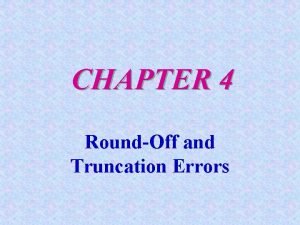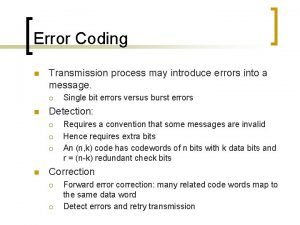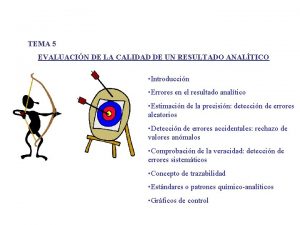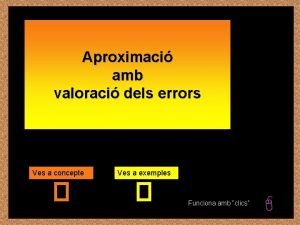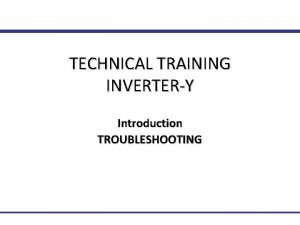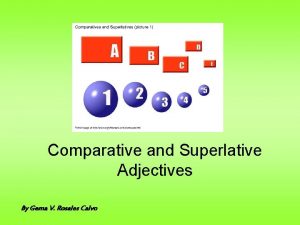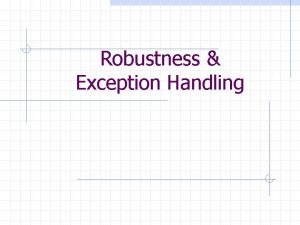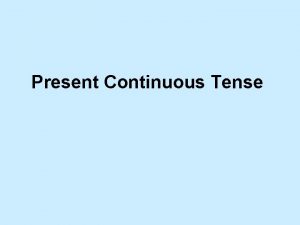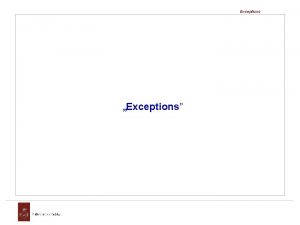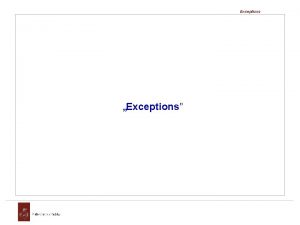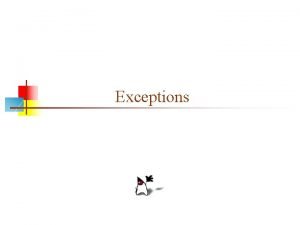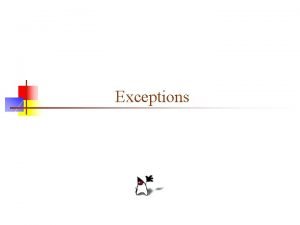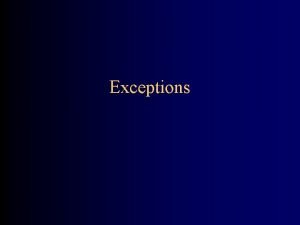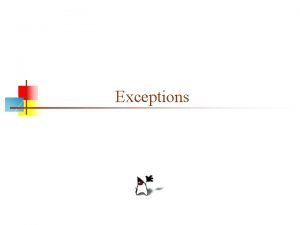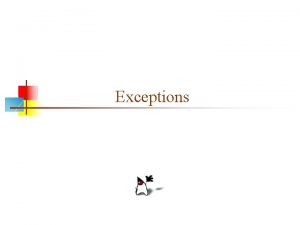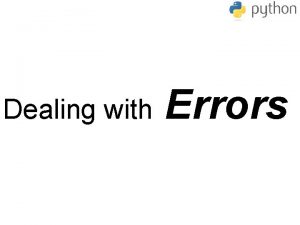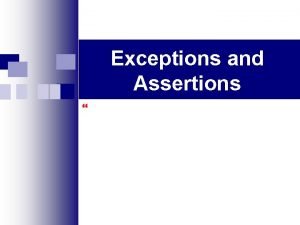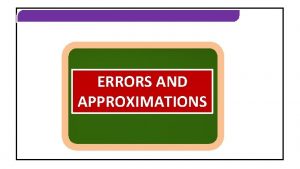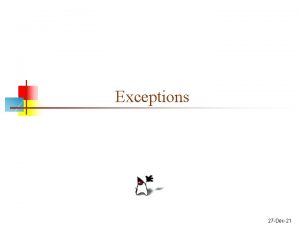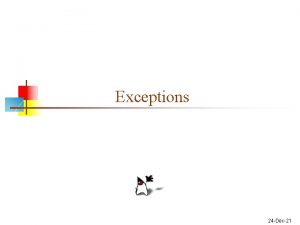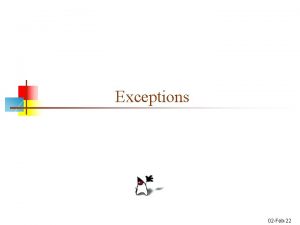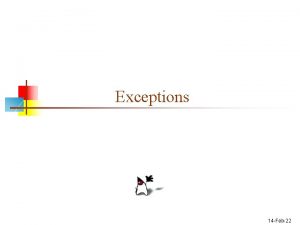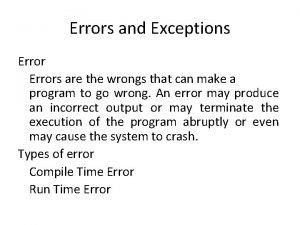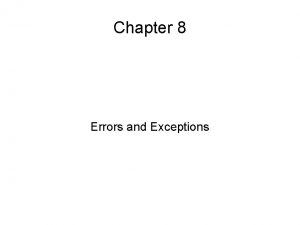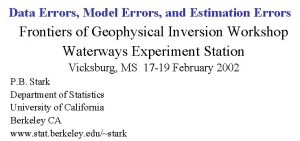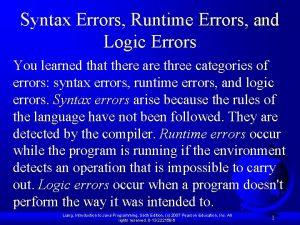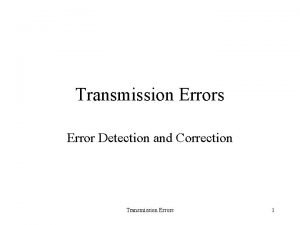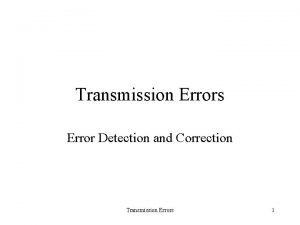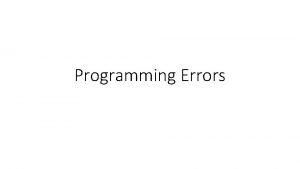Exceptions Errors and Exceptions n An error is



























- Slides: 27

Exceptions

Errors and Exceptions n An error is a bug in your program n n dividing by zero going outside the bounds of an array trying to use a null reference An exception is a problem whose cause is outside your program n n trying to open a file that isn’t there running out of memory 2

What to do about errors and exceptions n An error is a bug in your program n n An exception is a problem that your program may encounter n n It should be fixed The source of the problem is outside your program An exception is not the “normal” case, but. . . your program must be prepared to deal with it This is not a formal distinction–it isn’t always clear whether something should be an error or an exception 3

Dealing with exceptions n Most exceptions arise when you are handling files n n A needed file may be missing You may not have permission to write a file A file may be the wrong type Exceptions may also arise when you use someone else’s classes (or they use yours) n n You might use a class incorrectly Incorrect use should result in an exception 4

The problem with exceptions n Here’s what you might like to do: n n n But here’s what you might have to do: n n n n open a file read a line from the file open a file if the file doesn’t exist, inform the user if you don’t have permission to use the file, inform the user if the file isn’t a text file, inform the user read a line from the file if you couldn’t read a line, inform the user etc. , etc. All this error checking really gets in the way of understanding the code 5

Three approaches to error checking n Ignore all but the most important errors n n Do something appropriate for every error n n n The code is cleaner, but the program will misbehave when it encounters an unusual error The code is cluttered, but the program works better You might still forget some error conditions Do the normal processing in one place, handle the errors in another (this is the Java way) n n The code is at least reasonably uncluttered Java tries to ensure that you handle every error 6

The try statement n Java provides a new control structure, the try statement (also called the try-catch statement) to separate “normal” code from error handling: try { do the “normal” code, ignoring possible exceptions } catch (some exception) { handle the exception } catch (some other exception) { handle the exception } 7

Exception handling is not optional n n As in other languages, errors usually just cause your program to crash Other languages leave it up to you whether you want to handle exceptions n n n There a lot of sloppy programs in the world It’s normal for human beings to be lazy Java tries to force you to handle exceptions n n This is sometimes a pain in the neck, but. . . the result is almost always a better program 8

Error and Exception are Objects n n In Java, an error doesn’t necessarily cause your program to crash When an error occurs, Java throws an Error object for you to use n n n You can catch this object to try to recover You can ignore the error (the program will crash) When an exception occurs, Java throws an Exception object for you to use n n You cannot ignore an Exception; you must catch it You get a syntax error if you forget to take care of any possible Exception 9

The exception hierarchy n Throwable: the superclass of “throwable” objects n n Error: Usually should not be caught (instead, the bug that caused it should be fixed) Exception: A problem that must be caught n n Runtime. Exception: A special subclass of Exception that does not need to be caught Hence, it is the Exceptions that are most important to us (since we have to do something about them) 10

The Exception hierarchy II Throwable Error Need not be caught Exception Must be caught Runtime. Exception 11

A few kinds of Exceptions n IOException: a problem doing input/output n n n File. Not. Found. Exception: no such file EOFException: tried to read past the End Of File Null. Pointer. Exception: tried to use a object that was actually null (this is a Runtime. Exception) Number. Format. Exception: tried to convert a non-numeric String to a number (this is a Runtime. Exception) Out. Of. Memory. Error: the program has used all available memory (this is an Error) There about 200 predefined Exception types 12

What to do about Exceptions n You have two choices: n You can “catch” the exception and deal with it n n You can “pass the buck” and let some other part of the program deal with it n n For Java’s exceptions, this is usually the better choice This is often better for exceptions that you create and throw Exceptions should be handled by the part of the program that is best equipped to do the right thing about them 13

What to do about Exceptions II n You can catch exceptions with a try statement n n When you catch an exception, you can try to repair the problem, or you can just print out information about what happened You can “pass the buck” by stating that the method in which the exception occurs “throws” the exception n Example: void open. File(String file. Name) throws IOException {. . . } n Which of these you do depends on whose responsibility it is to do something about the exception n n If the method “knows” what to do, it should do it If it should really be up to the user (the method caller) to decide what to do, then “pass the buck” 14

How to use the try statement n Put try {. . . } around any code that might throw an exception n n This is a syntax requirement you cannot ignore For each Exception object that might be thrown, you must provide a catch phrase: n n n catch (exception_type name) {. . . } You can have as many catch phrases as you need name is a formal parameter that holds the exception object You can send messages to this object and access its fields 15

finally n n n After all the catch phrases, you can have an optional finally phrase try {. . . } catch (An. Exception. Type e) {. . . } catch (Another. Exception. Type e) {. . . } finally {. . . } Whatever happens in try and catch, even if it does a return statement, the finally code will be executed n n If no exception occurs, the finally will be executed after the try code In an exception does occur, the finally will be executed after the appropriate catch code 16

How the try statement works n n The code in the try {. . . } part is executed If there are no problems, the catch phrases are skipped If an exception occurs, the program jumps immediately to the first catch clause that can handle that exception Whether or not an exception occurred, the finally code is executed 17

Ordering the catch phrases n A try can be followed by many catches n n The first one that can catch the exception is the one that will catch the exception Bad: catch(Exception e) {. . . } catch(IOException e) {. . . } n This is bad because IOException is a subclass of Exception, so any IOException will be handled by the first catch n The second catch phrase can never be used 18

Using the exception n When you say catch(IOException e), e is a formal parameter of type IOException n n A catch phrase is almost like a miniature method e is an instance (object) of class IOException objects have methods you can use Here’s an especially useful method that is defined for every exception type: e. print. Stack. Trace(); n This prints out what the exception was, and how you got to the statement that caused it 19

print. Stack. Trace() n print. Stack. Trace() does not print on System. out, but on another stream, System. err n n n Eclipse writes this to the same Console window, but writes it in red From the command line: both System. out and System. err are sent to the terminal window print. Stack. Trace(stream) prints on the given stream n print. Stack. Trace(System. out) prints on System. out, and this output is printed along with the “normal” output 20

Throwing an Exception n n If your method uses code that might throw an exception, and you don’t want to handle the exception in this method, you can say that the method “throws” the exception Example: String my. Get. Line( ) throws IOException {. . . } n If you do this, then the method that calls this method must handle the exception 21

Constructing an Exceptions are classes; you can create your own Exception with new n n Exception types have two constructors: one with no parameters, and one with a String parameter You can subclass Exception to create your own exception type n But first, you should look through the predefined exceptions to see if there is already one that’s appropriate 22

Throwing an Exception n Once you create an Exception, you can throw it n n throw new User. Exception("Bad data"); You don’t have to throw an Exception; here’s another thing you can do with one: n new User. Exception("Bad data"). print. Stack. Trace(); 23

Why create an Exception? n n n If you are writing methods for someone else to use, you want to do something reasonable if they use your methods incorrectly Just doing the wrong thing isn’t very friendly Remember, error messages are a good thing—much better than not having a clue what went wrong n Exceptions are even better than error messages, because they allow the user of your class to decide what to do 24

Review: the assert statement n n The purpose of the assert statement is to document something you believe to be true There are two forms of the assert statement: n n n assert boolean. Expression; assert boolean. Expression : expression; By default, Java has assertions disabled—that is, it ignores them n To change this default n n n Open Window Preferences Java Installed JREs Select the JRE you are using (should be 1. 6. something) Click Edit. . . For Default VM Arguments, enter –ea (enable assertions) Click OK (twice) to finish 25

Assertions or Exceptions? n Exceptions n n n The assert statement n n Are used to catch error conditions “from outside, ” such trying to read a file that doesn’t exist Can also be used to check parameters, or the state of an object, to warn users of your class that they have done something wrong Is used as “live” documentation, to specify something that you believe will always be true If you can think of circumstances where it won’t be true, you should not be using assert But because assert is easier than Exceptions, it can sometimes be used for error checking in your own private methods Philosophy: You have to get your own class correct; you can’t expect other classes to be correct n Assertions are “internal; ” Exceptions are “external” 26

The End 27
 Type of errors in statistics
Type of errors in statistics How to avoid parallax error
How to avoid parallax error Round off error
Round off error Crc example
Crc example Absolute error
Absolute error Type 2 vs type 1 error
Type 2 vs type 1 error True bearing vs relative bearing
True bearing vs relative bearing Hypothesis format
Hypothesis format Power series expansion formula
Power series expansion formula Error sistematico y error aleatorio
Error sistematico y error aleatorio Error
Error Validez interna y externa
Validez interna y externa Error absolut i error relatiu
Error absolut i error relatiu Ipm error/ igbt error daikin
Ipm error/ igbt error daikin During error reporting, icmp always reports error messages
During error reporting, icmp always reports error messages Superlatives exceptions
Superlatives exceptions Non predefined exceptions in oracle
Non predefined exceptions in oracle Bad superlative
Bad superlative Comparatives safe
Comparatives safe Spl exceptions
Spl exceptions Robust programs
Robust programs Stark law exceptions
Stark law exceptions Present continuous tense of sew
Present continuous tense of sew Php exception
Php exception What is microbiology
What is microbiology Koch's postulates exceptions
Koch's postulates exceptions Pasteurized milk meaning
Pasteurized milk meaning Stark law exceptions
Stark law exceptions


